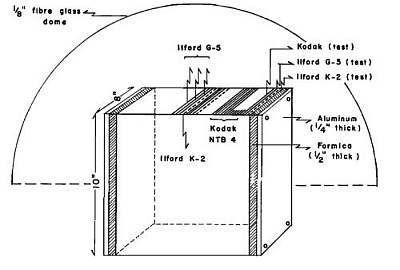Purpose of the flight and payload description
The objective of the flight was the exposure of large stacks of stripped emulsions at high geomagnetic latitudes, to investigate the charge spectrum of low energy cosmic ray particles.
The emulsion stacks were planned to be flown in such a manner that they would be positioned in the proper geometry only after the balloon had reached flight altitude. For this purpose a mechanism called the stack flipper was constructed at Rochester and installed in a large 1/4" fibre glass gondola purchased from L.C. Renslow of St. Paul, Minnesota. The emulsion stack consisted of 112 Ilford G-5 and 36 Ilford K-2 emulsions placed after every three G-5 emulsions. There were 19 Kodak NTB4 emulsions kept at one end of the stack. The Ilford emulsions were 20 cm by 25 cm by 0.06 cm, and the Kodak 20 cm by 25 cm by 0.0625 cm. At left can be seen a scheme of the gondola.
Details of the balloon flight
Balloon launched on: 8/4/1962
Launch site: Fort Churchill Airport, Manitoba, Canada
Balloon launched by: Raven Industries Inc.
Balloon manufacturer/size/composition: Zero Pressure Balloon
End of flight (L for landing time, W for last contact, otherwise termination time): 8/4/1962
Balloon flight duration (F: time at float only, otherwise total flight time in d:days / h:hours or m:minutes - ): F 13 h 52 m
The stack was flown onboard a stratospheric balloon launched from Fort Churchill, Manitoba, Canada on August 4, 1962. The plane of the emulsion was kept horizontal until it reached the ceiling when it was rotated through 90º to make the 25-cm side vertical. The balloon floated under 4.2 g/cm2 of residual atmosphere for 13 hours and 52 minutes, maintaining an almost constant latitude.
External references
- Isotopic Composition and Energy Spectrum of Low Energy Helium Nuclei in Primary Cosmic Radiation Journal of Geophysical Research, vol. 69, issue 17, pp. 3681
- The energy dependence of the abundance of lithium, beryllium, and boron in the primary cosmic radiation- observations at fort churchill at NASA technical reports server
- The flux of protons in the primary cosmic radiation over fort churchill at NASA technical reports server
6028If you consider this website interesting or useful, you can help me to keep it up and running with a small donation to cover the operational costs. Just the equivalent of the price of a cup of coffee helps a lot.


